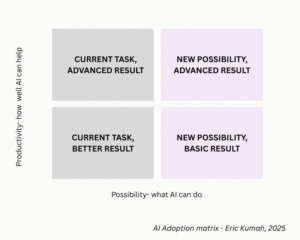By Eric KUMAH
You won’t believe what I am about to tell you! 4 out of 10 skills your team currently have will become obsolete by 2030. Yes, that is according to data released by the World Economic Forum in the Future of jobs report, 2025.
There are many reasons for this and AI – artificial intelligence is chief among them. Let that sink in. There are two ways to look at this information. One way is to panic and worry about an uncertain future. Another way is to take it as a sign to prepare for what is coming, or in some cases, what is already here.
Some people have called AI the biggest opportunity business and marketing has seen since the arrival of the internet. They are not wrong because the question isn’t whether AI will transform your organization, the question is when will this happen? And will you be the driver, a passenger or a rejected traveler?
What is AI in marketing?
Artificial intelligence is a broad term that covers a wide range of technologies. Whenever a technology is so broad, specialists start to narrow down and see how to apply the broad technology to a specific discipline like marketing.
So AI in marketing is the use of smart technologies like machine learning and data analytics to understand consumer and shopper behavior, personalize experiences, automate tasks or even create new experiences to serve consumers in new and better ways.
As marketers and business managers, we can use AI to help us predict what customers want, deliver the right message at the right time, and optimize campaigns for better ROI. Whether you’re targeting leads, managing customer journeys, or analyzing performance, AI gives you sharper insights and greater efficiency.
In a world where personalization and speed matter. Because of the immense power, AI is not just another tool. It is becoming a competitive advantage and every day you don’t use AI, somebody out there is using it and getting better.
What can AI do for your organization?
Let’s take a typical FMCG organization in West Africa that is into the end to end production, marketing and sales of a physical product like soap or food.
Identifying gaps in the market
In the past, marketers review experience from past launches, commission market scan studies over several months, run manual competitor tracking, and apply personal judgement to make choices of where to play.
Now with AI, predictive analytics analyze trends, competitor activity, and customer preferences to forecast demand, recommend pricing, and tailor launch messaging. The result is a more data driven choice and a smarter go-to-market strategy with less guesswork.
Understanding consumer sentiment
Experienced marketers know how hard it is to manage consumer feedback. It takes skill to see the unwritten and hear the unspoken because sometimes what is not being expressly said is actually what is being said.
This is where AI is useful. Natural Language Processing (NLP) scans social media, reviews, and customer service logs to spot emerging trends, complaints, or praise instantly. It can read email trails and decipher the hidden emotions. With this, the brand stays ahead of the consumer mood.
Showing impact of marketing on sales results
This has been a problem for ages. People have always wanted to show who marketing activities move the needle in sales. The pressure is getting higher as some organizations are now consolidating sales and marketing into a growth role.
Today with AI, link models can track customer journeys across devices and stores, connecting actual sales to digital ads, links clicked on various platforms etc. Marketers finally see the full picture of what’s driving sales and how they can optimize.
Content creation for diverse markets
Many years ago, I was managing a global brand and we had to fly teams to Indonesia, UK, South Africa, and Nigeria to get multiple models to shoot alternate scenes to localize an advert. There were multiple voiceovers recorded by different voice artistes for cultural relevance. Today with AI, there will be no need for that.
A strong creative person can use AI to create an entire video, then proceed to auto-generate and translate content tailored by culture, language, and behavior to deliver local relevance. With so much progress made in AI videos in between May and June 2025, we are heading to a place where large companies will roll out full campaigns created with just a prompt.
Better response to market changes
Sometimes there are major category defining moves in the market place, like a competitor price drop or a viral trend. Businesses wish they were more agile to grab those opportunities.
With AI powered dashboards monitor market signals in real-time (including competitor pricing, shelf data, and trending topics) and alert teams instantly. Marketers can pivot fast, seize opportunities, or protect market share proactively. From these five scenarios, you can see how AI can add value to your efforts in a marketing organization.
What are the levels of AI adoption in business?
You can use AI to do existing tasks in a more efficient way, or do them in a different way. You can also use AI to do new possibilities to a basic standard or do them to an advanced standard. It all depends on the needs of your organization and where you want to go.
I propose an original framework for types of AI adoption for teams and organizations. My framework is based on two levers – Possibility – what technology can do, and Productivity – how well it can do it. Simplifying into four boxes;
- Current Task, Better Result; Current Task, Advanced Result; New Possibility, Basic Result; New Possibility, Advanced Result

No two organizations are the same so there is no one size fits all. Each organization or team can adopt AI to a level that suits their needs. Whenever I advise leaders on AI, I always encourage small steps to pilot and see results that build belief before scaling up.
What steps to follow to adopt AI in your marketing team?
First is the mindset shift. To get the best of AI, businesses need to use the mindset that AI is not just a new tool in an existing toolbox. If you use it like that, you will seriously underutilize its capability, like having Christiano Ronaldo on your soccer team and using him as a cheerleader. Assuming a typical marketing department with 6 people and a head of marketing who sits on the business leadership team.
- Step 1: Start small – Pick one task you do often and let AI handle it. For example, reading social media comments for sentiment, creating reports, or scoring leads. Choose something that takes time and try AI on it. Early results build belief.
- Step 2: Clean your data – To launch you will need to make time to clean up your date. AI needs clean input to give good output. Fix your files, adjust formats, and make sure the data is ready. You’ll spot issues from your first test.
- Step 3: Raise your champions – Pick team members who can lead and influence others. Support them with leadership backing so they can drive adoption.
- Step 4: Launch and track – Roll out one AI use case, track time saved, and share results publicly. Quick wins build momentum.
- Step 5: Build AI culture – Make AI part of everyday work culture. Hold learning sessions, celebrate progress, and grow AI skills across the team. Without culture, energy will go down.
Conclusion
There is no need to fear the future if you prepare well. Remember, the playing field is equal so your competitors are also at the same point with AI now. The difference between those who will lead and those who will follow is not a big budget or fancy technology. It is about who will make the decision to start today, learn fast, and adapt faster. The future of marketing is not coming – it is already here. And it’s waiting for you to claim it. Like I say in my executive AI coaching programmes, the new world of AI is here, and you will not be left behind.
>>>the writer is a marketing leader and business strategist who has worked on some of West Africa’s most familiar consumer goods brands. He is a leading voice on AI in Marketing and the Creator of GetAhead AI training for Marketers and Business professionals. He is recognized by LinkedIn as a Top Voice in Marketing and Business management, and the author of the 5 Skills in Marketing book. Contact Eric Kumah on LinkedIn or ekmarketingplus [at] gmail [dot] com










